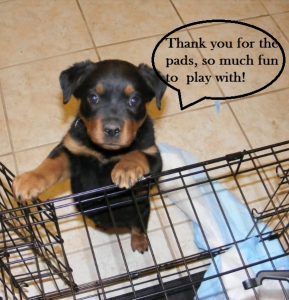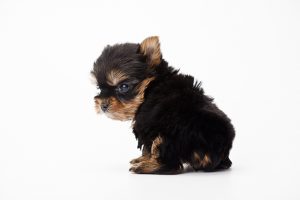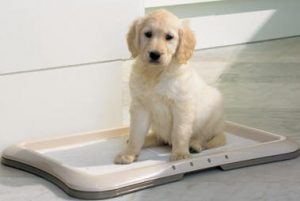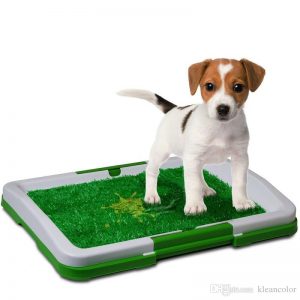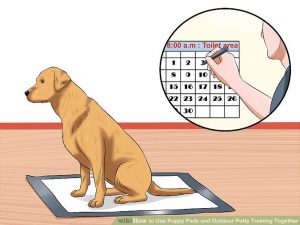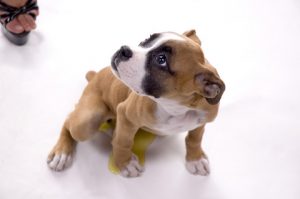Congratulations, you just got a new puppy! As most other puppy owners, one of your first issues to deal with is potty training puppy. It’s usually the first thing clients ask me about.
The key to house breaking a puppy is the frequency puppy is taken out to do their business, as well as management to make sure puppy is set up to succeed. By management I mean play pens, crates, leashes and long lines. This may also include pee pads. I know that some people prefer to skip the pads all together, which is fine, but I also like to give the puppy an appropriate option if no one can take him out in time. For pee pads, my rule of thumb is that so long as one foot is on the pad, then the puppy did the right thing. I usually suggest a pee pee pad tray as well, as many puppies find the pads too irresistible not to chew and destroy.
Play pens are great for when you cannot supervise your puppy. They’re in a safe place, unable to wander around and get into trouble. Leashes and long lines are used to make sure puppy can’t get too far away to eliminate somewhere else in the house.
Crates are great for house training as well. The important thing is the size of the crate though. It’s important that it’s not large enough for puppy to go pee at one end and have enough room to lie down at the other end, totally away from where he pee’d. The crate needs to be small enough to let puppy stand and turn around. That’s it. Most puppies naturally will not eliminate where they sleep and eat. So keeping the crate small will work along with their natural behaviors of keeping their areas clean. Most crates come with a divider for this very purpose, to make the crate smaller at the beginning when potty training.
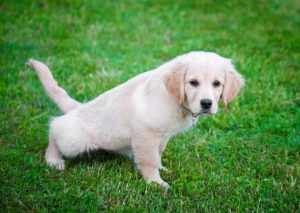
Feeding and watering schedules are important too, to help us set up bathroom break schedules as well. I don’t restrict water during the day, but I do at night time when house breaking. I usually feed puppy two or three meals a day, always around the same time.
This helps determine when puppy will need to poo, as they’ll usually poo the amount of time they’re fed plus one more time. Two meals usually equal three poops. I don’t recommend free feeding, and this is one of the reasons why.
Puppies also learn to hold their poops sooner than they do their pee. So expect routine poops quite early.
The regular guideline for how long puppies can hold their bladders amounts to how many months old they are, give or take half an hour. So this translates to a two month old puppy being able to hold himself for an hour and a half to two hours, and a three month old, two and a half hour to three hours and so on. This is providing that the puppy already has some experience in holding themselves though. If not, shave off it off to one hour less, just to be safe.
There are other times they need to be taken out as well. Most puppies can last longer during the night, with one or two potty breaks depending on age. But they need to go out as soon as they wake up in the morning, within 15 minutes of eating and drinking, after waking up from a nap, and after every play session. All of these times are on top of their hourly potty breaks.
The only time that the schedule changes is overnight. Most young puppies still need a potty break or two during the night. It shouldn’t take long to figure out their night potty needs, as they’ll usually whine or cry when they need to go. When you take them out, don’t fuss and play with puppy. Leash, take out, potty, then back in the crate.
When it’s time for a potty break, take puppy out on a leash. The on leash part is very important. Don’t let puppy have free run of the yard. Take puppy to his potty place and give him just five minutes to do his business. Five minutes. Do not wait around for thirty minutes waiting for puppy to pee. Five minutes. If puppy does potty, then praise for a job well done. You can give a treat if you like, but it’s not necessary. Emptying a full bladder or bowel is reinforcement enough. You’d be surprised at how smart some puppies are. I’ve met a few who’ve gotten cookies for peeing outside who then learn to assume the squatting pee position, without peeing at all, in the hopes of getting a cookie. Smart puppies!
What is important after they potty outside though, is not to come right back into the house. Too many people make this mistake, and end up with a puppy who holds himself until he come back into the house, where he promptly pees or poos. We never want puppy to learn that eliminating outside signals end of fun time outside. So after a pee or a poo, stay outside and play with your puppy for a few minutes before returning back into the house.
This now brings us to what to do if puppy doesn’t potty when on his five minute potty break. Don’t wait any longer, but rather bring puppy back into the house, but keep the puppy on leash and under supervision. Take him out again every ten minutes, or if you notice him sniffing, circling, whining or showing any other signs of preparing to relieve himself. When outside give him just the five minutes, repeating as often as necessary to ensure that puppy is outside when he feels the need to eliminate. Make sure not to give puppy free time to run off and pee somewhere. Keep him on leash.
The important thing to remember is that we will get better results if we have puppy outside to pee before he actually feels the need to pee. This is why keeping to the schedule is so important.
Puppies are also very habitual, so if you keep bringing puppy to the same spot, this will become his potty spot.
If you chose to add the pee pad option (which I recommend, because we often aren’t strict enough with potty scheduling) then you can do the same thing with the pad. You can also leave a pee pee or two on the pad to encourage puppy to return to it when the need arises. I don’t clean or remove pee pee pad with just one pee.
There are also fake grass options as well, as opposed to pee pads. They’re square patches of astro turf type grass, and some use actual real grass, and they’re used in the same fashion as pee pee pads.
When it comes to praising puppy I also wait until the puppy has finished their business. I never want to interrupt puppy mid flow. The same goes for if they make a mistake and potty in the house. I never interrupt. We don’t want puppy learning that going potty is a bad thing. If we do, we may end up with a puppy who learns to go in hiding places, such as behind the couch. Instead, we want to teach puppy where to go, and we do this by pre-emptively having puppy where we want them to potty before they actually feel the need to do so.
If you follow this schedule, you won’t have many accidents in the house. Put do prepare yourself for some. They are young puppies after all, and still learning. Make sure to have the proper cleaning agents as well. Household products such as Hertel and the like aren’t recommended, because they cannot properly remove all odors. Remember how much stronger a dog’s sense of smell is compared to ours. Even if we can’t see it or smell it doesn’t mean that your dog can’t. So it’s best to get an enzyme removing product. I like Nature’s Miracle and Knock Out. If soiled areas aren’t properly cleaned, then they just become beacons to our pups, flashing lights and all.
If you happen to find an accident, go get yourself a newspaper or a slipper and bring the puppy to the soiled area. Take a good hold of the paper or slipper and begin to smack yourself over the head with it, while chanting ‘I forgot to watch my dog, I forgot to manage my dog, I forgot to take my dog out’. Not many repetitions of this should be required.
While potty training may be annoying, following these steps will reduce the number of accidents in your home, and quickly teach puppy where they are supposed to do their business.
Good luck and Happy Training!
Meira
 Montreal Dog Blog Montreal's Online Dog Park
Montreal Dog Blog Montreal's Online Dog Park



